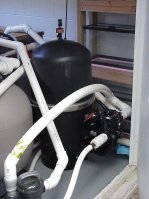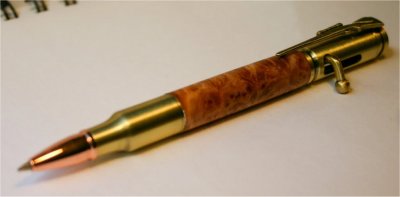AquaScapes gravel bottomed pond installations – by Doc Johnson
- Wildly popular and easy for landscapers to install
- Attractive
- Cost effective
- Beautiful when fully planted
- No immediate hazard to fish
- You can’t argue a single point of this
First look:
 The filters and gravel bottomed ponds they install work admirably until the fish grow, or until enough mulm accumulates to kill everything. The essential problem is that the bottoms of these installations are “done” in river gravel and this traps and holds fish wastes, dead plant leaves, etc. The organics build up over time, usually 36 months*, when the accumulation of nitrogen and hydrogen sulfide start to cause “poor doers” among groups of growing Koi. I have been to fish calls in many of these instances and the culprit is the trapped mulm accumulation and the noxious gases they produce. But I’ve learned that this neglect is not the way the system is intended or engineered to be managed.
The filters and gravel bottomed ponds they install work admirably until the fish grow, or until enough mulm accumulates to kill everything. The essential problem is that the bottoms of these installations are “done” in river gravel and this traps and holds fish wastes, dead plant leaves, etc. The organics build up over time, usually 36 months*, when the accumulation of nitrogen and hydrogen sulfide start to cause “poor doers” among groups of growing Koi. I have been to fish calls in many of these instances and the culprit is the trapped mulm accumulation and the noxious gases they produce. But I’ve learned that this neglect is not the way the system is intended or engineered to be managed.
*The eco system pond (Aquascape) is intended to be cleaned out once a year. So you can see that 36 months is THREE years of neglect and it’s still a functioning system (albeit with some water quality issues)
Here’s what some people are saying.
“The filtration system is horrible. It’s one of those Aquascapes skimmer things. There is so much rock in the pond. The filter has lava rock in it. It is NOT Backwashable. The nitrites are 0. Ammonia is 0. PH is 7.8. Temp was 75 yesterday. And Since I sent you the email, I lost a couple more fish. Here is a picture of one of them. Some of them are looking a little bit better with the injections. I hope this isn’t a herpes virus though, If it is, what should I do? Everyone else I’ve been asking about this problem says its the rock in the pond and a poor filter system.” JB (letter on file)
Also: “My 3 year old (12’x30′) pond with biofalls skimmer system has tea colored water that is not clearing up but has gotten even darker. My concern is that it has never lasted this long (three weeks). There is no mulch to cause discoloration from runoff. I am concerned for our fish (koi, shubunkins, comets,etc). Any suggestions?
Gratefully,
Smith Family”
In separate correspondence from another party:
We have a lot of ponds in this area that are being installed as “natural” ponds. They typically have between 18 and 24 inches of rock and gravel in them. I’m starting to get calls from people with sudden fish deaths and I feel certain I’m seeing a hydrogen sulfide problem. My question is, does hydrogen sulfide poisoning affect the gill color? The fish I saw had light pink to whitish gills, but it may have been because they had been dead for several hours and were refrigerated.
Mr. Soest has good luck with Aquascapes systems. He takes his system COMPLETELY apart every spring. He has a cosmetic result and a good clear pond.
Greg L. is an Aquascapes installer and he also has good luck with the system. He shares: “These ponds are attractive and have been healthful to the fish as long as they are cleaned up every Spring. Every year, we move all the fish to holding containers and drain the pond completely. The sides and bottom are thoroughly pressure-washed to remove all the mulm and debris. We refill the ponds and the entire process takes from one to three days depending upon the size of the installation. Our success rate with the ponds is great.”
Another email:
 Hi my name is Beth and I currently work a garden nursery that specializes in water gardens and koi/goldfish ponds. My coworkers and I feel that placing gravel or stone along the bottom of the ponds will create a great deal of problems in the future for the hobbyist and the fish. We have been arguing with a company that swears by placing gravel on the bottom of these ponds without any bottom drain or any real circulation. I was wondering what your opinion was about the rocks on the bottom? I have had a hard time trying to convince people that just because it looks natural doesn’t mean it will work like a naturally occurring system. Anyway your opinion would be greatly appreciated. Thank you very much 🙂 (my fish thank you too)
Hi my name is Beth and I currently work a garden nursery that specializes in water gardens and koi/goldfish ponds. My coworkers and I feel that placing gravel or stone along the bottom of the ponds will create a great deal of problems in the future for the hobbyist and the fish. We have been arguing with a company that swears by placing gravel on the bottom of these ponds without any bottom drain or any real circulation. I was wondering what your opinion was about the rocks on the bottom? I have had a hard time trying to convince people that just because it looks natural doesn’t mean it will work like a naturally occurring system. Anyway your opinion would be greatly appreciated. Thank you very much 🙂 (my fish thank you too)
Beth
Response:
It’s great if you tear down and clean the entire installation every year.
Many people don’t know that it can be easy to have a Koi pond with daily monitoring of the physical plant (filtration and water movement), and they think a total weekend overhaul every Spring is normal and common practice. Handling the fish is stressful for them unless done properly at the proper time of year.
I have my doubts that all landscapers and installers are as dedicated to the maintenance of these systems as they should be*, however in those cases where they are, and where they DO clean out the systems every year, the hydrogen sulfide problems you would normally anticipate are averted. I’ve had an Aquascape installation at Koilab for years. We tested it repeatedly for Hydrogen Sulfide and found NONE. That is an overrated if not unlikely problem if the pond is maintained.
*I know for a fact that (like any industry) there are landscapers and installers who don’t even KNOW that there’s a tear down every year
Greg L. I have gotten very positive feedback from owners and installers who are not “put off” by the annual tear down procedure.
Point well made; that with *annual* labor the gravel bed on the pond bottom are not a liability to water quality.
Still, this Spring, more than half of the ponds I’ve seen and consulted on were afflicted with noxious gases and accumulated nitrogen from neglected forms of these gravel bottomed ponds. The key word is ‘neglected’
Doc Johnson: I have not been called upon to treat an Aquascape pond that is properly maintained. During the annual cleanout, the fish and pond need to be carefully handled. I wrote a long document and presentation on how to do the cleanout. I will be uploading that as I can.
Finally, I’d mention that one intrepid soul drained their pond. They removed all the river rock. Then they mixed cement with the river rock and spread the whole “goulash” back into the pond. Before it dries, they spray the surface of the new “pad” off with a hose so the surface rocks are “prominent” in the mosaic on the bottom. Allowed to fully cure, they refilled the pond and did a couple water changes to remove residual concrete lime. Now they have the look of river rock without the ABILITY for solids and detritus to get amongst the rocks.
If you have fish that “really need to get back into their home soon” you won’t have the time to do this, curing can take a little while and residual lime can cause problems for a little while afterwards. Restocking initially with sacrificial fish is recommended.
This was done in Colorado.





